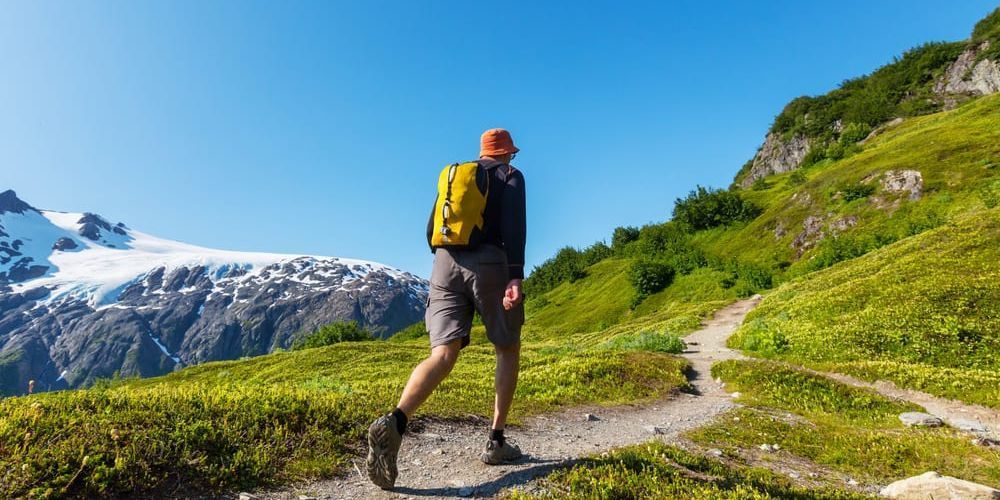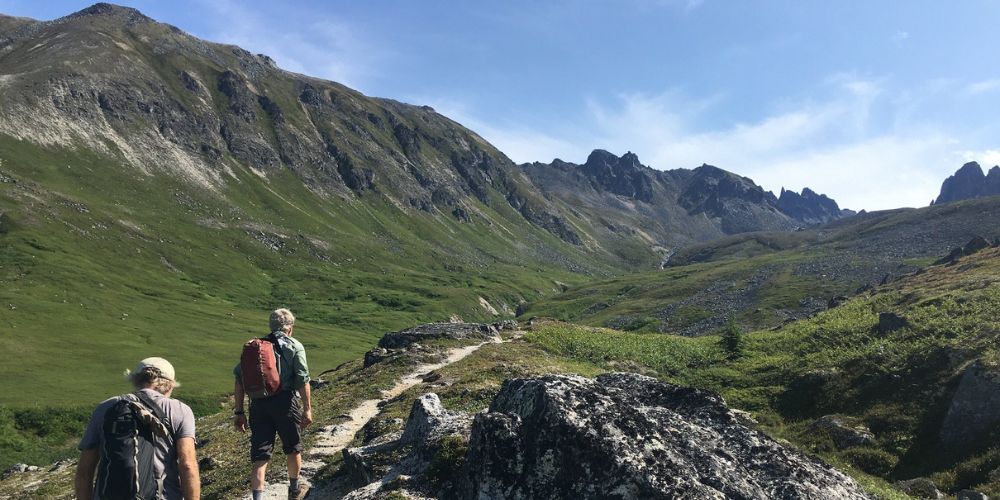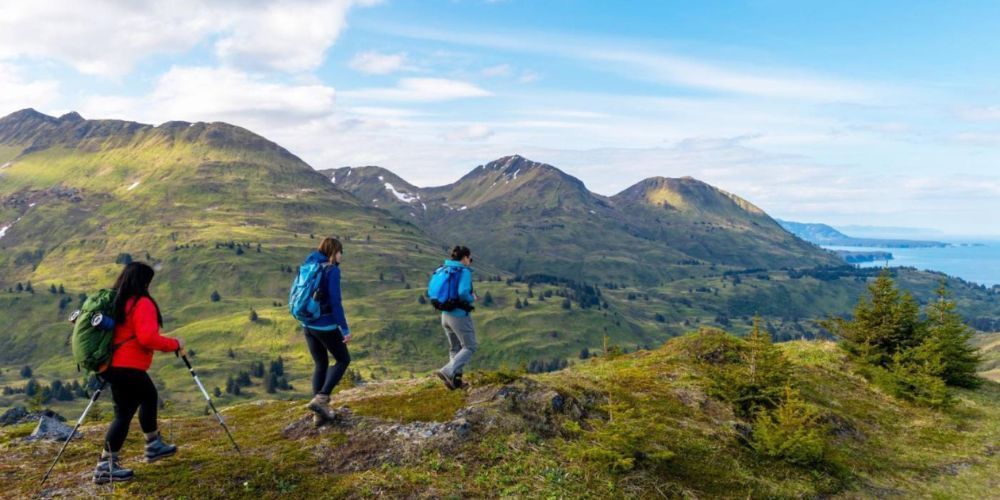Hiking in Alaska: Discover the Best Trails and Outdoor Adventures
Hiking in Alaska offers an unparalleled connection with nature's raw beauty. Imagine ambling along the Kenai River Trail near Cooper Landing, where every turn in the 10-mile journey reveals sparkling waters framed by lush forests. Or picture yourself standing breathless atop Harding Icefield Trail in Seward, having conquered over 3,000 feet of elevation to behold an icy expanse that seems to stretch endlessly.
While the allure of Alaskan wilderness draws many adventurers, planning such an excursion requires careful consideration. From layers of sturdy clothing to essential safety gear like bear spray, preparation is key to enjoying these remote landscapes safely. Knowing which trails suit your skill level and understanding what gear to carry can make all the difference. Having combed through countless trail reports and gathered insights from seasoned hikers, we've compiled a comprehensive guide to help you confidently embark on your Alaskan adventure.
One of the iconic hikes in Alaska is the Harding Icefield Trail in Kenai Fjords National Park, offering stunning views of the icefield. Another remarkable option is the Winner Creek Trail near Girdwood, known for its hand tram and lush scenery. It's important to remember that when hiking in Alaska, it's recommended to bring layers, water, proper climbing gear, bear spray, and bug spray to ensure a safe and enjoyable adventure.

Top Recommended Hikes in Alaska
Alaska, also known as "The Last Frontier," is a treasure trove of hiking trails that offer a myriad of landscapes and experiences for hikers of all levels. From coastal panoramas to rugged mountain terrains, there's something for everyone. Let's explore some of the top recommended hikes in this stunning state.
Kenai River Trail near Cooper Landing
Nestled amidst stunning wilderness, the Kenai River Trail near Cooper Landing stretches over 10 miles round-trip. It offers awe-inspiring views of the majestic Kenai River, winding through enchanting forests and rugged terrain—ideal for moderate hikers. The lush surroundings and the calming sound of the flowing river create an unforgettable hiking experience, leaving visitors enchanted by the natural beauty of Alaska.
Harding Icefield Trail in Seward
For those seeking a more exhilarating adventure, the Harding Icefield Trail in Seward awaits. This strenuous 8.2-mile round-trip trek challenges hikers with an elevation gain of over 3,000 feet. As you ascend, prepare to be mesmerized by the otherworldly grandeur of the Harding Icefield. The panoramic vistas from this trail are spectacular, providing an unparalleled view of the icy expanse that defines this region—a truly immersive journey into Alaska's raw, untamed beauty.
Tony Knowles Coastal Trail in Anchorage
Spanning 11 miles one way, the Tony Knowles Coastal Trail offers breathtaking coastal views and glimpses of captivating wildlife such as moose and eagles. The ease of this trail makes it accessible to hikers of all levels, providing an opportunity for both casual strolls and invigorating bike rides along the coast. The tranquil ambiance, coupled with the chance encounters with Alaska's diverse fauna, makes this trail a must-visit destination for nature enthusiasts.
Flattop Mountain in Anchorage
A beloved hike among locals and visitors alike, the Flattop Mountain trail rewards adventurers with sensational 360-degree views of Anchorage and its surrounding landscapes. The 3.4-mile round trip offers hikers an immersive experience as they ascend to capture stunning panoramas from the mountain's summit. The accessibility and impressive scenery make this hike a popular choice for those looking to savor breathtaking views without embarking on a more arduous journey.
Whether you're drawn to coastal vistas or eager to conquer challenging elevations, Alaska's diverse range of hiking trails promises unforgettable outdoor experiences for every enthusiast. Each trail weaves its own story through Alaska's remarkable wilderness, inviting adventurers to immerse themselves in the state's natural wonders.
Now that we've explored some of Alaska's top hiking trails, let's gear up for our next adventure by delving into the must-have equipment for hiking in this rugged terrain.
Must-Have Gear for Hiking in Alaska
Before embarking on a thrilling hike through Alaska's breathtaking trails, it's crucial to ensure that you have the right gear to keep you comfortable, safe, and prepared for the unpredictable wilderness conditions. Layered clothing, sturdy hiking boots, bear spray, GPS devices, and maps are among the indispensable items you need to have with you.
Layered Clothing: A Key Element
In Alaska, the weather can fluctuate unexpectedly. Layering your clothing is essential to adapt to these changes effectively. Base layers, insulating layers, and waterproof outer layers are all fundamental components of a well-prepared hiker's wardrobe.
The base layer provides warmth and moisture-wicking properties, insulating layers help retain body heat in cold conditions, and waterproof outer layers shield you from rain or snow while allowing excess heat and moisture to escape. Brands such as Patagonia and North Face offer high-quality garments designed specifically for outdoor enthusiasts' needs.
Sturdy Hiking Boots: Your Trusty Companions
Alaska's rugged terrains demand sturdy hiking boots that offer excellent support and protection. Look for waterproof boots with good ankle support to navigate through the challenging landscapes with confidence. Brands like Merrell and Salomon are highly regarded for their durability and traction on various surfaces, providing stability on rocky trails and protecting your feet from potential hazards.
Bear Spray: Non-Negotiable Safety Measure
In bear country, carrying bear spray is not just a recommendation but an essential safety precaution. While encounters with bears are rare, it's imperative to be prepared for any unforeseen circumstances while exploring the wilderness. Always carry bear spray and be familiar with how to use it properly in case of a bear encounter, enhancing your sense of security during your outdoor adventure.
GPS and Maps: Navigating Safely
Alaska's remote trails often lack reliable cell coverage, making it essential to rely on other means of navigation. Carrying a GPS device alongside physical maps provides a dependable backup plan for keeping track of your location and staying on course. Familiarize yourself with both electronic and paper-based navigation tools to ensure a safe hike through varying landscapes without getting lost.
Equipping yourself with these vital pieces of gear ensures that you are well-prepared to face the challenges of hiking in Alaska's wild terrain. These items not only enhance your safety but also contribute significantly to a more enjoyable and worry-free outdoor experience amidst the stunning natural beauty of the state.
As you prepare to conquer the rugged Alaskan wilderness, arming yourself with the right gear is just the beginning. Let's now dive into the crucial aspects of preparing for the ever-changing weather conditions in this awe-inspiring landscape.
Preparing for the Weather
Hiking in Alaska is a thrilling experience, but it comes with its own set of challenges, mainly due to unpredictable weather patterns. Alaskan weather can change in an instant, from clear and sunny skies to sudden rainstorms or even snowfall. This means that when preparing for a hike, you must be well-informed and equipped for any weather eventuality.
One of the most crucial steps before heading out on a hike in Alaska is to check the latest weather forecasts. Reliable websites like Weather.com and local news channels provide accurate and up-to-date predictions that can help you plan your trip effectively. Be on the lookout for temperature changes, wind speeds, and any precipitation in the forecast. This information will not only help you dress appropriately but also guide your decisions on which trails to tackle based on the expected weather conditions.
Imagine setting out on a hike under clear skies, only to encounter heavy rainfall halfway through your journey. Without proper rain gear, you could end up soaked and cold, making the experience far less enjoyable. Hence, always make sure to pack a lightweight, waterproof jacket and pants, regardless of the forecast. These items can serve as a lifesaver when unexpected rain showers occur.
In addition to being prepared for rain, it's important to ready yourself for colder temperatures as well. Even during warmer months, the weather in Alaska can be chilly, especially at higher elevations. It's crucial to have cold weather accessories such as hats, gloves, and thermal socks. These small yet vital items can greatly enhance your comfort levels during a hike and ensure that you remain warm and protected from the elements.
By staying updated on the weather forecasts and packing appropriate clothing and accessories for both rainy and cold conditions, you'll be better equipped to handle the ever-changing Alaskan weather during your hiking adventures.
From understanding the challenges of unpredictable Alaskan weather to ensuring your safety at every turn, let's dive into essential guidelines for "Staying Safe in the Wilderness.
Staying Safe in the Wilderness
Before embarking on a hike in the Alaskan wilderness, it's important to understand that this journey is unlike a stroll in a local park. It's an experience that demands respect, preparation, and caution. Alaska's vast, untamed landscape is breathtakingly beautiful but can also be unforgiving if you're unprepared. Here are some essential safety tips to keep in mind before starting your adventure.
Stay Informed and Communicate
One crucial rule when heading out into the wilderness is to always inform someone about your plans. Before setting off, share your hiking itinerary with a friend or family member. Let them know the trail you're planning to take, your expected return time, and any alternative plans you might have if things change.
It's like having an extra set of eyes watching out for you from afar. This small action could be lifesaving should anything go wrong. Remember, it's always better to be over-prepared than under-prepared.
Pack a Comprehensive First-Aid Kit
A well-stocked first-aid kit is non-negotiable when venturing into the wilderness. The right gear can make all the difference between a minor inconvenience and a major catastrophe. Look for a first-aid kit specifically designed for outdoor activities, as they often contain items tailored to potential wilderness mishaps.
Consider carrying essentials such as bandages, antiseptics, pain relievers, blister treatments, and any personal medications that might be needed. Brands like Adventure Medical Kits are respected for their compact, comprehensive options.
Ensure Clean Water Supply
Water sources in the wilderness may be natural and scenic, but they can also pose health risks due to contamination. Carrying a portable water filter or water purification tablets is essential for ensuring a safe drinking supply during your hike.
Filtering or purifying your water is significantly important in preventing waterborne diseases that can quickly derail an enjoyable outing. Invest in reliable gear to keep yourself hydrated and healthy throughout your adventure.
Every safety measure you take adds another layer of protection against potential hazards, big or small. By staying informed and prepared, you're embracing the wild beauty of Alaska while maintaining peace of mind as you explore its scenic wonders.
As you equip yourself with these crucial safety measures, you'll soon find yourself ready to dive into the unique landscapes that define the heart of this wondrous state.

Exploring Unique Alaskan Landscapes
Alaska's landscapes are undoubtedly distinctive. From towering glaciers and icy terrain to stunning coastal views and vibrant alpine meadows, there's a wealth of natural beauty waiting to be explored. Let's dive deeper into the unique landscapes you can experience while hiking in Alaska.
Glacial Terrain
Alaska is home to some of the most breathtaking glacial landscapes in the world. One must-see destination is Exit Glacier in Kenai Fjords National Park. As you hike near these massive ice formations, you'll have the opportunity to witness the raw power of nature up close. Consider absorbing the sheer size and age of the glacier, and perhaps joining a guided tour to learn about the geology of the area. These experiences provide an unparalleled sense of humility and wonder in the face of nature's grandeur.
Coastal Views
Trails like Resurrection Bay in the Seward area offer hikers a striking coastal journey, complete with dramatic sea cliffs and captivating ocean wildlife. Imagine walking along the rugged coastline, gazing out at the vast expanse of the ocean, and witnessing diverse marine life in their natural habitat. Keep an eye out for seabirds soaring overhead and perhaps catch a glimpse of majestic whales gracefully navigating through the waves.
Alpine Meadows
If you're seeking a burst of vibrant colors amidst breathtaking scenery, hikes like Deer Mountain Trail in Ketchikan will lead you through enchanting alpine meadows. In these meadows, especially during summer, you'll encounter a rich tapestry of flora bursting into full bloom, painting the landscape with vivid hues. The contrast between lush greenery and vibrant wildflowers against a backdrop of majestic mountains creates an unforgettable experience for hikers.
Each of these unique Alaskan landscapes offers an immersive and awe-inspiring outdoor adventure, providing hikers with a profound connection to nature's splendor as they traverse these diverse terrains.
As we transition to the next section, get ready to tackle a different kind of challenge—the thrilling escapade that comes with overcoming wilderness obstacles.

Overcoming Wilderness Challenges
Alaska's rugged wilderness offers awe-inspiring scenery and adventurous trails, but it also presents unique challenges for hikers to confront. One of the key hurdles is navigating through river crossings. Many Alaskan trails feature river crossings, which can be unpredictable and dangerous, particularly during certain times of the year when water levels are high due to melting snow or heavy rainfall. It's crucial to exercise caution and analyze water levels and currents before attempting a crossing. Using trekking poles for stability and evaluating the depth and speed of the water is crucial. Always aim to cross at the shallowest and slowest part of the river, maximizing safety during this critical phase of the hike.
In addition to river crossings, hikers must prepare to encounter rough terrain along the trails. The paths in Alaska often lead through uneven, rocky, and challenging landscapes. To navigate these areas safely, wearing proper hiking footwear with excellent ankle support is essential. Slow, deliberate steps help maintain balance and ensure stability while traversing these rugged terrains. Hiking sticks or trekking poles can also provide added support and assistance in maintaining stability on uneven surfaces, reducing the risk of slips or falls.
Furthermore, being aware of potential wildlife encounters is an integral part of hiking in Alaska. Understanding local wildlife behavior is crucial for ensuring personal safety as well as respecting the natural habitat of these creatures. For instance, when encountering a bear, it's important to remain calm and avoid sudden movements. Running from a bear could trigger a predatory response, so it's advisable to stand tall, slowly increase your apparent size by raising your arms or backpack if safe to do so, and back away steadily without making direct eye contact. Having a clear understanding of local wildlife behaviors can significantly mitigate the chances of dangerous encounters.
These adversities may seem intimidating at first glance, but with proper preparation and knowledge, hikers can confidently explore Alaska's wilderness while minimizing risks associated with river crossings, rough terrains, and wildlife encounters.
As we venture deeper into the heart of Alaska’s natural wonders, it becomes evident that challenges bring not only risks but invaluable encounters with remarkable wildlife and nature sights.
Enjoying Wildlife and Nature Sights
As you navigate the trails of Alaska, a vibrant world awaits your discovery. It's not just about the paths beneath your feet but also the majestic creatures and breathtaking natural sights that fill the landscape around you.
Imagine yourself sitting by a serene mountain lake, the reflection of snow-capped peaks shimmering on its glassy surface, while graceful eagles soar overhead. This isn't a mere dream; this can be your reality when hiking in Alaska.
Bird Watching: Unveiling Nature's Masterpieces
Alaska is an ornithologist's paradise, boasting a diverse avian population. From the resplendent bald eagles to captivating puffins, each species has found a niche in this enchanting land. Carrying a pair of good binoculars for bird watching will bring you closer to these marvelous creatures as they go about their daily lives. Imagine spotting an eagle perched high in its nest or witnessing the acrobatic dives of puffins into the waters.
Encounters with Moose and Bears: A Glimpse into Wilderness Majesty
One unique aspect of hiking in Alaska is the opportunity for close encounters with moose and bears. Early morning and dusk are prime times for spotting these awe-inspiring creatures. However, it's essential to maintain a safe distance and use zoom lenses for photography. Admire them from afar; their presence emphasizes the untamed beauty of the Alaskan landscape.
Summer's Wildflower Meadows: A Riot of Colors
In the summer months, Alaska offers a stunning spectacle with its wildflower meadows. Places like Denali National Park are adorned with a vibrant riot of colors. Take some time to pause and appreciate these natural wonders, as the air fills with an array of scents, and vibrant hues stretch as far as the eye can see. The kaleidoscope of wildflowers not only adds to the scenic appeal but also plays a vital role in sustaining various local ecosystems.
The beauty of Alaska isn't confined to its landscapes but extends to its fascinating wildlife and breathtaking natural sights. By embracing these unique experiences, you'll gain a deeper understanding and appreciation for the harmonious coexistence between humanity and nature.
Author: William Flaiz
Check out these other activities in Alaska
Check out activities in these nearby states: Washington , Oregon , California , Hawaii
